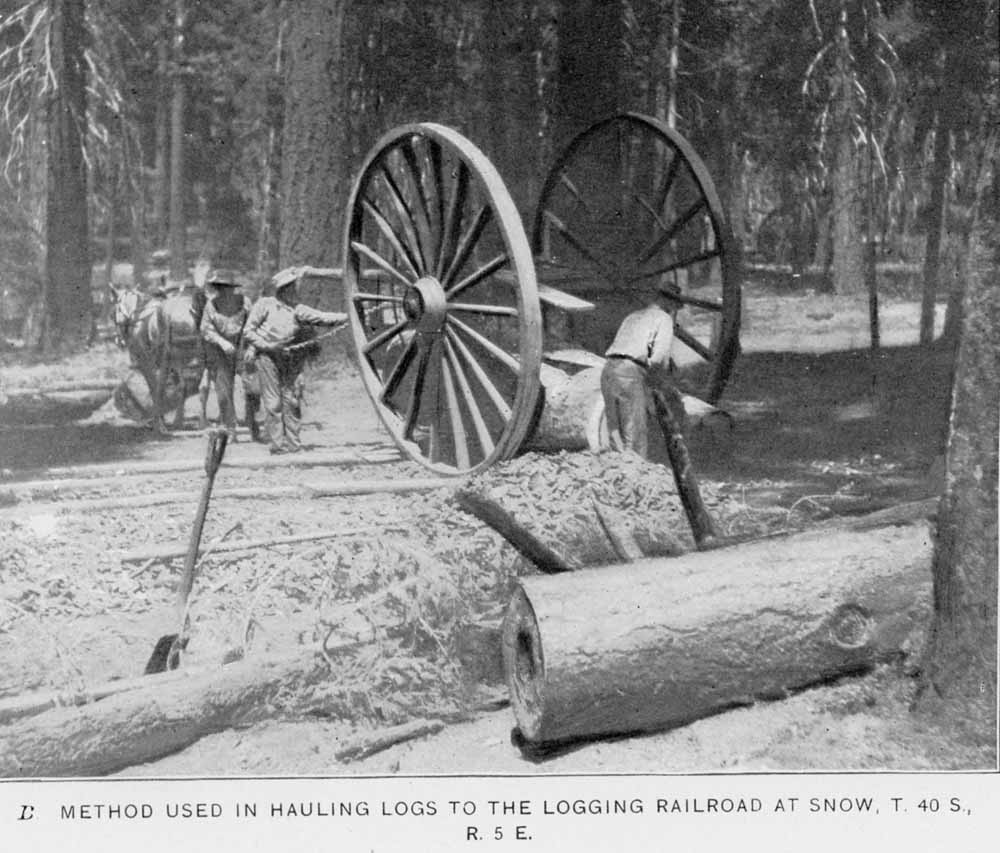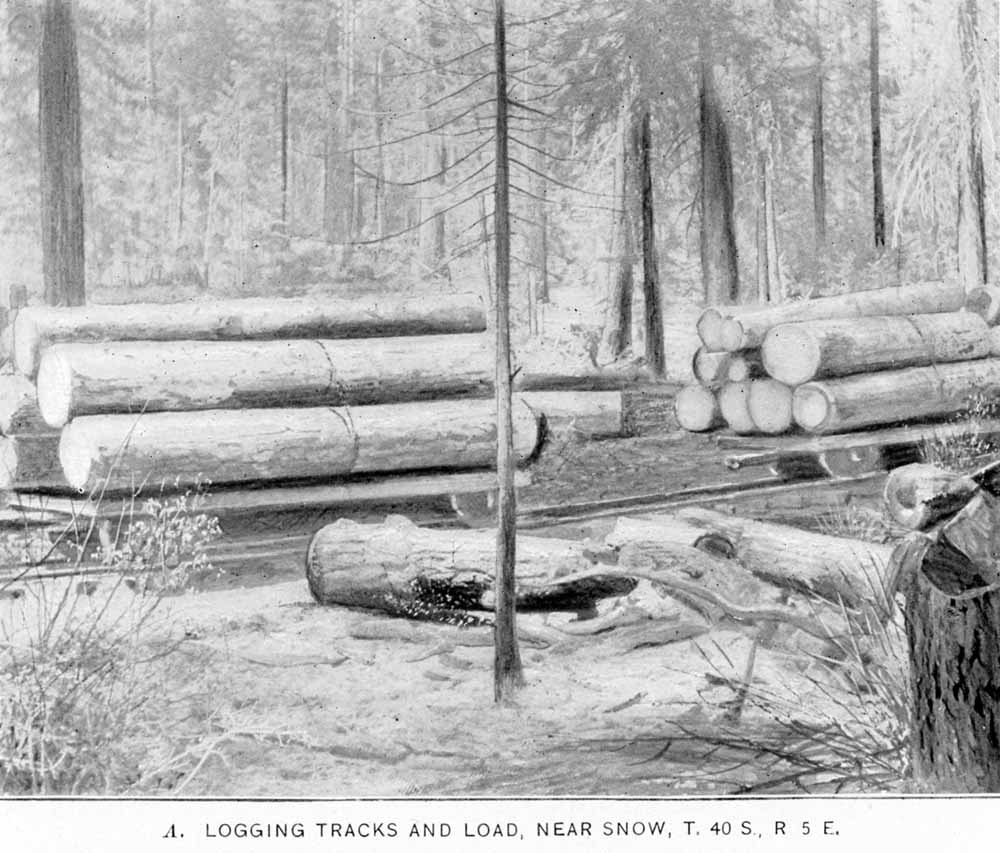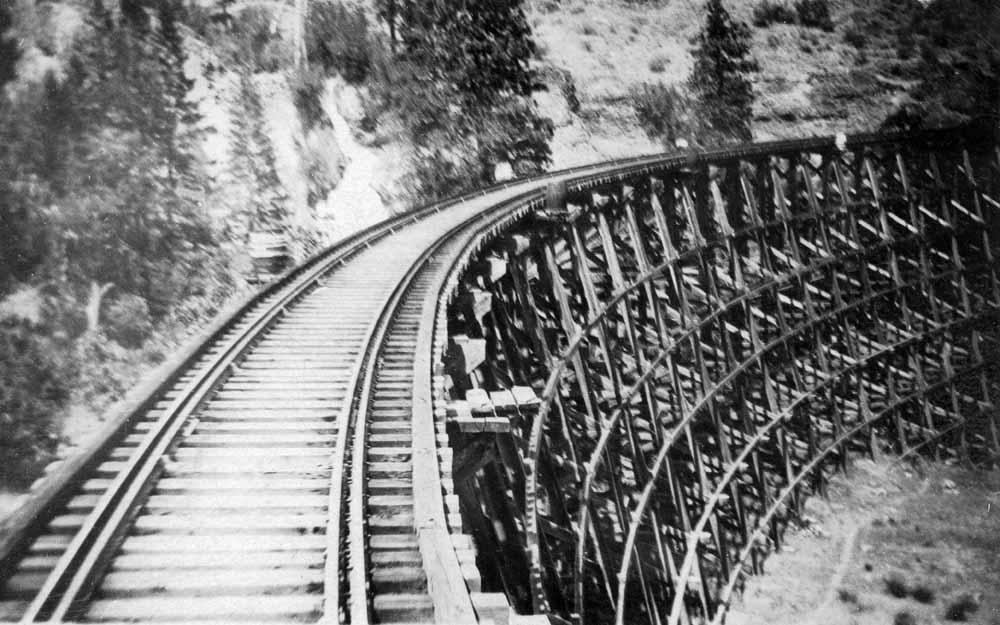|
Klamath River Lumber Company Pokegama Sugar Pine Potter's Mill Klamath Lake Railroad Oregon Southern Railroad |
|
|
 |
|
Klamath River Lumber Company/Pokegama Sugar Pine/Algoma Lumber Company #1, the Old Blue.
|
|
|
|
History A Michigan based company named Pardee, Cook & Company acquired subtantial timberlands just north of the Oregon-California border in both Jackson and Klamath counties in the late 1800s, and by 1891 the company built a large sawmill and associated facilities on the Central Pacific/Southern Pacific main line at a point along the Klamath River in California initially named Klamath City, then Pokegama, and finally Klamathon. The company, operating as the Klamath River Lumber & Improvement Company then later as the Klamath River Lumber Company, planned to drive their logs down the Klamath River to Klamathon, and to facilitate delivery of the logs to the water the company built a 2,600 foot long log chute that dropped logs the 832 vertical feet from the top of the canyon walls. The operation initially used animals to skid logs from the holdings directly to the top of the chute, but as the distance to the timber increased the company realized it needed a railroad to haul logs over the ever increasing distances. The railroad at the start used gravity to move the loaded log cars from the cutting areas to the top of the chute, with horses used to pull the empty cars back up the hill. In 1893 the company bought a small Baldwin 0-4-2T from the Pasadena street railroad that quickly got tagged with the name Old Blue. The railroad eventually extended approximately ten miles north into the woods from the top of the chute.  Early day logging on the Klamath River Lumber Company from United States Geological Survey's 1899-1900 Annual Report.  Loading logs on the cars for the trip to the chute, also from United States Geological Survey's 1899-1900 Annual Report. One Harvey Lindly from Los Angeles leased the operation on 7 April 1897 and later purchased it, he renamed it the Pokegama Sugar Pine Lumber Company. The company had long suffered from a major problem affecting most operations that tried using river drives to move logs, namely wildly fluctuating water and flow levels that made log drives difficullt. The company partially solved this by building a splash dam upstream from the log chute, which would impound water until enough logs had accumulated below the chute. This method, while it generally worked, created a lot of problems with other downstream users of the river. Pokegama decided to replace the log drives with a railroad, and on 12 December 1901 they incorporated the Klamath Lake Railroad to build a common carrier line running from Laird's, California- later renamed Thrall- east into the timber. The 24.7-mile long main line, completed in 1903, ran along the Klamath River east from Thrall for a little shy of ten miles before climbing out of the canyon using a combination of several stiff grades, a pair of switchbacks, and several large timber trestles. The railroad established its eastern terminous at New Pokegama. Unfortunately, the railroad never fulfilled its intended purpose as a fire destroyed the Klamathon mill on 13 October 1902, and the Pokegama Sugar Pine abandoned its logging railroad as the Klamath Lake Railroad arrived to the area. However, New Pokegama lay thirty miles from Klamath Falls, and the railroad was able to start living a marginal existence on freight and passenger traffic going to or from the city. Lindly indicated he would extend the railroad to the city if provided with a subsidy, be he could not reach agreements with the city. Lindly instead sold the railroad, and more importantly the timberlands, to Weyerhaeuser in 1905. The railroad did end up serving two other independent sawmills. In 1903, Ray Potter built a small mill two miles north of New Pokegama that he operated as Potter and Son Mill. Potter and/or the railroad built a spur north to the mill, possibly partially on the old Pokegama Sugar Pine grade. There were apparently a few logging railroad spurs built to haul logs to the mill, which operated until about 1906. Then, in 1908, the Algoma Lumber Company built a sawmill south of New Pokegama along with a small network of its own logging railroads. Algoma purchased and used the old Pokegama Sugar Pine locomotive and log cars, supplemented by some other equipment the company purchased.  Oregon Southern #259 with the passenger train along the Klamath River. Jeff Moore collection. Weyerhaeuser changed the name of the railroad to the Oregon Southern Railroad in 1907. The railroad existed pretty much only to serve the Algoma operation after the Southern Pacific's California & Northeastern completed its line into Klamath Falls in 1909, and once the Algoma operations closed and moved to Rattlesnake Point in 1911 the outer parts of the railroad served no further purpose, and the company abandoned the eastern most 14 miles of its railroad. The remaining part of the Oregon Southern survived for a while longer due to a series of hydroelectric projects built along the Klamath River. The Siskiyou Light and Power Company broke ground on the first of these, at Copco in 1910, and in 1912 they leased the remaining part of the Oregon Southern Railroad from Weyerhaeuser and assumed operations. Successor California Oregon Power Company bought the railroad in 1921. The railroad saw sporadic operations in 1920-1921 and then 1924-1925 in connection with a couple construction projects, but saw very little if any use after 1925. Final abandonment happened in 1942 when the U.S. Army purchased the rails for use in the railroad built at Camp White, Oregon. Weyerhaeuser ended up finally logging the timberlands in the old Pokegama area in the 1930s, using spurs built into the area from the north. More recent development has eliminated most traces of the old Pokegama and Klamath Lake Railroad operations, leaving only a few stretches of grade as remnants of their existence. |
|
|
Maps |
|
Overview map of the Klamath Lake Railroad and Pokegama logging railroads.
|
|
|
|
Locomotive Roster Klamath River Lumber Company/Pokegama Sugar Pine 1- Baldwin 0-4-2T, c/n 9081, Built 1888. Built as Pasadena City Railroad #1, Pasadena, CA; to Klamath River Lumber Company #1, named Old Blue; to Pokegama Sugar Pine Lumber Company #1, ; to Pokegama Milling Company; to Algoma Lumber Company. Abandoned in woods near Pokegama after 1911, where it remained until scrapped around World War Two. Klamath Lake Railroad/Oregon Southern Railroad/California Oregon Power Company 1- Baldwin 2-6-2, c/n 27686, Built 1906. Cylinders 16x24, Drivers 44", Boiler Pressure 180 lbs., Tractive Effort 24,200 lbs., Weight 67 tons. Acquired new. Muddled history, but probably transferred to Weyerhaeuser's Cherry Valley Timber Company in 1913. Sold circa 1939 to Amador Central Railroad #6, Martell, CA. Scrapped 1945. 2- Lima 2-Truck Shay, c/n 646, Built 1901. Built as Mill Valley & Mount Tamalpais Scenic Railway #3, Mill Valley, CA; to Mt. Tamalpais & Muir Woods #3; to California Oregon Power Company #2 1915; to Hetch Hetchy Railroad (leased); to Flora Logging Company, Carlton, OR, 1923; to Northwest Equipment Company, Portland, OR; to Union Lumber Company, Union Mills, WA, 1929. Scrapped 1929. 3:1- Porter 0-4-2T. Sold to Starr Lumber Company, Oakland, CA. No other information. 3:2- Alco 0-6-0, c/n 3425, Built 1891. Drivers 50", Weight 44 tons. Built as Northern Pacific Terminal #3, Portland, OR; to Railway Equipment & Supply; to Siskiyou Power & Light #3:2. 7- Lima 2-truck Shay. No other information. 259- Rogers 4-4-0, c/n 2483, Built 1878. Cyilinders 18x24, Drivers 58", Weight 33 tons. Built as St. Paul & Pacific Railroad #31; to Great Northern #259 1899; to Klamath Lake Railroad #259 1905; to Oregon Southern Railroad 1907; Scrapped 1913 at Ashland, OR. ?- Lima 2-Truck Shay, c/n 2410, Built 1911. Cyliners 8x10, Drivers 27.5", Tractive Effort 12,850 lbs., Weight 28 tons. Built as Shaw-Bertram Lumber #1, Klamath Falls, OR; to California Oregon Power Company, Thrall, CA; to Independence Foundry Company 1929; to Clackamus Fir Lumber Company, Beaver Creek, OR; to Molalla Lumber Company, Beaver Creek, OR, 1929. ?- Climax 2-Truck, c/n 886, Built 1908. Weight 40 tons. Built as Northern California Lumber Company #2, Hilt, CA; to Fruit Growers Supply Company #2, Hilt, CA; maybe to California Oregon Power Company (conflicting/uncertain records); later used in building Southern Oregon Traction Railroad at Medford; to Prouty Timber Company, Timber, OR, circa 1921; to C.H. Wheeler, Cochran, OR; to Eagle Lumber Company, Westimber, OR; to Wheeler Lumber Company, Westimber, OR; last listed as for sale by them April 1924. In addition, Klamath Lake Railroad leased Oregon & California Railroad 4-4-0 #1254 circa 1902. |
|
|
|
Photos |
 |
|
A postcard view of Klamath Lake Railroad's Fall Creek Trestle.
|
 |
|
Builder's photo of the Klamath Lake Railroad #1.
|
 |
|
A second builder's photo of the Klamath Lake Railroad #1.
|
 |
|
Klamath Lake Railroad #3:1 at Thrall. John T. Labbe Collection of Logging and Railroad Photographs, 1892-2010, Washington State Archives,
Digital Archives, http://www.digitalarchives.wa.gov.
|
 |
|
Amador Central Railroad #6, originally built as Klamath Lake Railroad #1, in Martell, California, on 2 May 1943. Robert M. Hanft photo, Jeff Moore collection.
|

|
|
Vintage colorized postcard of the Mt. Tamalpais & Muir Woods #3, destined to work for the California Oregon Power Company in the future. Jeff Moore collection.
|
|
|